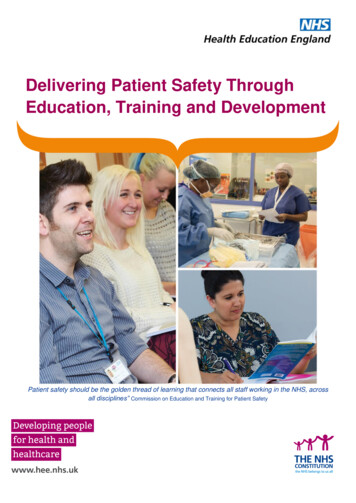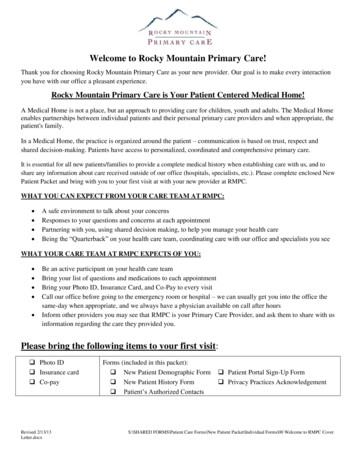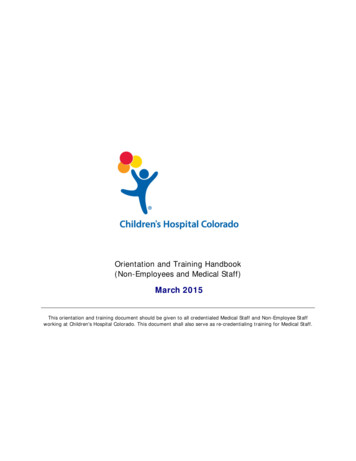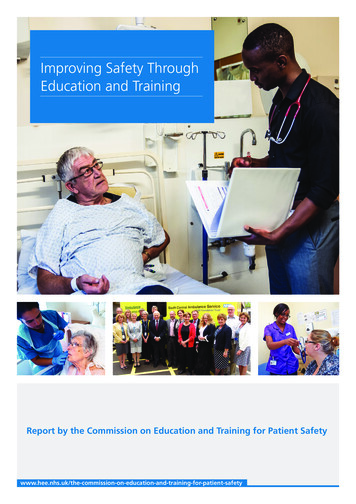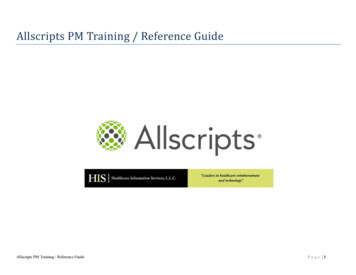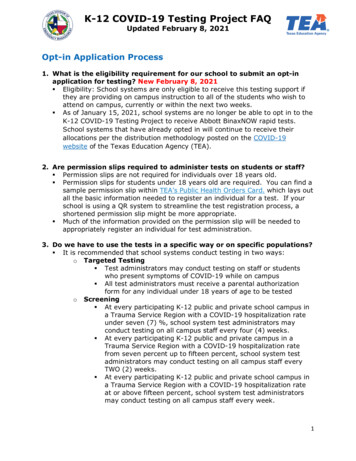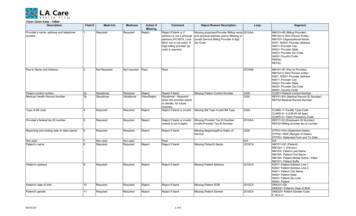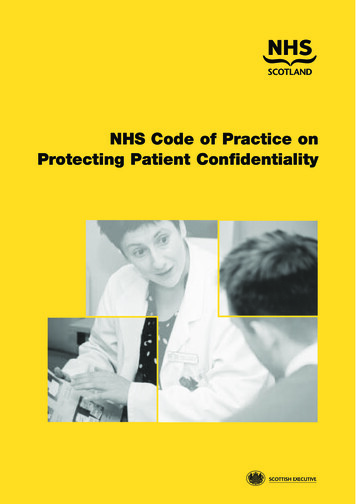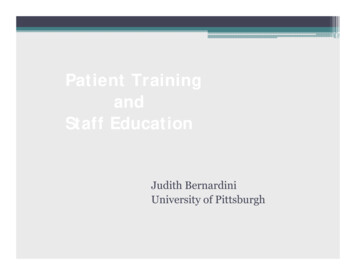
Transcription
Patient TrainingandStaff EducationJudith BernardiniUniversity of Pittsburgh
Outline This talk reviews the recommended steps toprepare the nurse to educate patients for homePD. Continuing education for the nurse and theroles of nephrologists and clinic administratorsare also addressed. In addition, the principles ofadult learning are applied to the specific needs ofhome PD patients who must learn bothprocedures and problem solving. A literaturereview is included to evaluate research in patienteducation for peritoneal dialysis.
Nurses as teachers: Most health professionals have little or no formalbackground in the principles of education The complexity of the task of teaching is oftenoverlooked Many (especially MD) assume the skills will developautomatically Even with the best intentions, the results may behaphazard, inefficient and ineffective
www.ISPD.orgBernardini J. Price V, Figueiredo A. ISPD Guidelines/Recommendations.Peritoneal Dialysis Patient Training, 2006.Perit Dial Int 2006:26(5);625-632 ISPD Nurse Liaison Committee developed a video forpreparing nurses to teach patients to compliment thepublished ISPD Guidelines. Guidelines and handouts available for download May be used for individual nurses or for groups ofnurses
How are nurses prepared totrain home dialysis patients? Many simply given the job Assumption that the skills will be acquired Sent to a course on home therapy Often has little or no instruction on teaching /learning Assumption that if know how to do dialysis, can teach it tothe patient Sent to a course on teaching and learning Sent to an experienced training nurse for mentoring**The role of doctors and administrators is to plan thepreparation and continuing education of training nurses.
Becoming a Patient Educator Learn the principles of educationDevelop training skillsFind a mentorNever be complacent about acquiring new skills and newmethods of teachingAfter one becomes an experienced trainer,should be a mentor for other nurses.
Who is the learner? Patient only ISPD recommends 1:1 nurse patient ratio for PD Some centers have 1:2 or 1:3 or even 1:4 ratios There are no studies to confirm effectiveness There are no recommendations for home HDtraining ratios. Patient with a partner Partner only Parent / Guardian
The Science of the LearnerBallerini and Paris, KI, Nosogogy: When the learner is a patient with chronic renalfailure, 2007, 70, 122-126.PEDAGOGYANDRAGOGYThe LearnerdependentindependentPreviousexperienceof little worthrich resourcefor learningSubjectslearn whatsociety expectslearn whatthey chooseto knowNOSOGOGYdependentaiming toindependencesomethingto modifylearn what renalstaff expects andwhat they need toperform
What is to be learned? Specific motor skills Concepts Procedures which require both motor skills and concepts Problem solvingLearning is not just memorizing facts.
A Teaching Plan An outline or a detailed course Teaching aids Mannequin or apron with practice PD catheter Blackboard, felt board or paper board Video or audio tapes, internetWhere to train?clinichomehospitalalternate site
Training RoomNo other activities in the roomduring trainingA room with a door forprivacy and quietWork surface and sinkfor hand washingIV poleChairforpatientrestscaleAble to wash up spillsclock
How long should training last? There are no randomized trials to compare thelength of training with outcomes Training should continue until the patient can safely perform all required procedures recognize a contamination and an infection andappropriate responses
How do nurses train patients today?Bernardini J, Price V, Figueiredo A, Riemann A, Leung D. International survey ofperitoneal dialysis training programs, Perit Dial Int 2006:26(5);658-663. ISPD Nurse Liaison Committee distributed asurvey in 2005 in US, Canada, S. America,China and The Netherlands. 317 responses from PD nurses
Total number of hours trained for PDTotal HoursTrainingforPD70.0p 0.00160.050.040.030.0Hong Kong20.010.0USThe NetherlandsCanadaS. Am0.012345
Relationship of HoursTrainedto Peritonitis:Relationship of DaysTrainedTo Peritonitis:What can we conclude from the survey?100.0100.090.0Total HoursTrained80.070.090.0--not enough evidencetosuggesthow long180.0US4Hong Kong last.training 30.040.0Let’s look at otherresearch 30.0Lets look at additional research 20.020.010.010.00.0-0.50.0-0.50.51.5Episodes of peritonitis per year2.50.51.52.5
New Directions in Peritoneal DialysisTraining Hall G et al. NNJ 2004;31(2) Centers randomly assigned 621 patients to Enhanced training, 246 patients Standard training, 374 patients Follow-up for 418 patient years, 1.5 years/patient Enhanced training group had lower infection rates forboth ESI and peritonitis.
Pediatric Peritoneal Dialysis Training:Characteristics and Impact on PeritonitisRates. Holloway M. PDI 2001;21 Evaluated 76 pediatric PD training programs Lowest peritonitis rates found in Programs with 15 patients Programs with longer training time focused on theory andtechnical skills
Influence of Peritoneal Dialysis Nurse’sExperience on Peritonitis Rates.Chow KM et al, CJASN;2:2007 Retrospective study Evaluated nurse trainer’s length of PD experience with patientincidence of peritonitis Paradoxically, found that patients trained by nurses with themost experience had the highest rates of peritonitis Speculated that those who have practiced PD for many years maynot be as familiar with the substantial changes in ourunderstanding of adult learning and curriculum
How should the patient be taught? Tell the patient what they are going to learnwhat they must dowhat the trainer will dohow both will know that learning has occurred
Example: The nurse says You are going to learn how to make a sterileconnection from the bag to your catheter. First you will learn the steps of the procedure. You will watch me as I do the steps, and then readaloud each step as I do it. When you are able to say all the steps in the rightorder, you will perform the steps on the mannequinwhile repeating aloud each step. You will be ready to do the connection on your owncatheter when you can perform the steps without amistake 3 times in a row.
Acquiring PD ProceduralMotor SkillsLearningthe steCognitivepsProgrammingthe brainPracticeAutonomicRecognizingerrors Muscles learn to follow the brain’sinstructions through 3 distinct stages oflearning.
Learning Motor Skills STEP 1: Patient describes or reads each step; thentrainer performs them STEP 2: Patient does NOT practice procedure untilable to describe each step STEP 3: Patient practices the procedure using themannequin with PD catheter, describing each step asperformed STEP 4: When able to perform Step 3 successfully,patient performs procedure using own catheter
Teaching about peritonitis: Teacher describes a symptom: ask patient to guess if itmight be peritonitis Use of pairs One very likely, one very unlikely Move on to another pair not so easily differentiatedClearvery cloudyclearslightly cloudy
Learning Procedures A series of motor skills If demonstrated from start to finish, the mindsees them together and stores them that way. Each part of a procedure may be taughtseparately but must then be reassembled inorder
Rules of Practice Never unsupervised until patient is able to dosuccessfully No practice until steps accurately described Always practice on mannequin until skill mastered Immediate feedback from the trainer Tell what doing right Stop when mistake made (NOT LATER) Redirect learner to place where no mistakes made Guide learner through problem areas Avoid “don’t do this” Do not teach why during motor skill learning
Tips from the pros Most people learn 1/3 of what is taught Combining visual and audio messages increaseslearning No more than 3-4 key messages / hour ---sessions 30 minutes---breaks every 2 hours. Try not to get ahead of the learner by telling themwhat to do. Most personal learning experiences are NOT helpfulas teachers Education is not just repeating directions Patient motivation does not directly increaselearning
Problem Solving Define problemList solutions----have patient pick oneEvaluate resultsTry another solution if neededEncourage to seek advise from others
Example of problem solving:Nurse: “You notice that the fluid is not clear when youcheck it before going on the cycler one night. Whatshould you do? Wait until morning to see if you feel sick? Check the next day to see if it is still not clear? Call the dialysis nurse right away?Nurse: “What do you think might be the problem? You have the flu You have peritonitis There is nothing wrong
Re-TrainingRusso et al, KI 2006 70,S127-132 Analysis of compliance to identify need for retraining 2 phase study: Patient Questionnaire (353 patients) Home visit / score card Re-training needs greater for patients 55 years old lower education 18 months on PD 36 months on PD
Evaluating your training program: Track patient outcomes Infection rates peritonitis, ESI, TI for PD ESI and sepsis for HD Hospitalization rates Deaths Transfers off home therapy Periodic reassessments of patient technique andproblem solving
Summary Nurses can provide outstanding training for theirpatients if they apply the principles of learning. We need to establish standards for home training(PD and HD). We need to evaluate the outcomes of various trainingmethods to determine the best approach for patients. Future research Randomized trials of different training techniques,times, places, trainers. compare outcomes of current practices
Question #1 The principles of adult education indicate that the bestway to teach PD to patients is to A. Provide them with a video to practice on their own. B. Always practice doing exchanges using their ownPD catheter. C. Explain the principles of sterile technique after theylearn how to do a procedure . D. Begin to practice procedures only after learning thesteps while watching the trainer perform them. E. Determine if a patient is highly motivated as theywill learn at a much faster pace.
Question #1: Correct answer D
Question #2 Which of the following statements about PD patient education istrue? A. A thorough knowledge of PD will adequately prepare the nurseto train patients. B. Patients with the most experienced trainers will have thelowest rates of peritonitis according to a recently published study. C. The number of hours and days needed to train a patient for PDis well established in the literature. D. The patient must be able to recognize a contamination andknow the appropriate responses before being sent home fromtraining. E. The role of the nephrologist is to assure that patients arecarefully selected for PD. F. A skilled trainer can assist with clinics and other duties whiletraining a patient for PD.
Question #2: Correct answer D
How are nurses prepared to train home dialysis patients? Many simply given the job Assumption that the skills will be acquired Sent to a course on home therapy Often has little or no instruction on teaching /learning Assumption that if know how to do dialysis, can teach it to the patient Sent to a course on teaching and learning Sent to an experienced training nurse for mentoring
